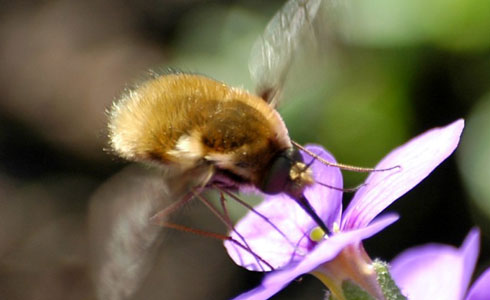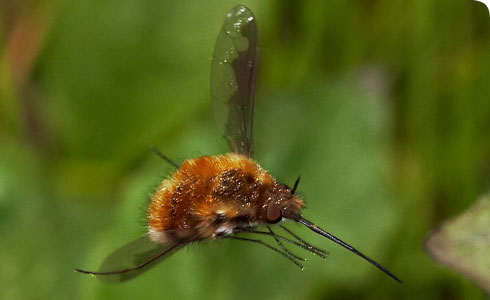Bombylius major (large bee-fly)
The large bee-fly is a bee mimic - it resembles a small bumblebee.
The adult flies are striking and have a hairy body with long hairy legs and a characteristically long, slender tongue which they use for nectar retrieval whilst hovering beside a flower head.
Bombylius major larvae parasitise beetle larvae as well as the brood of solitary wasps and bees - another reason for its name.
The female has been seen to flick her eggs mid-air into the ground bees’ and wasps’ nests.
Species detail
-

Taxonomy
Bombylius major was first named by Linnaeus in 1758, but has since been incorrectly identified as many other things. Discover some of its alternative names.
-

Distribution
Bombylius major can be found in most parts of the world, apart from Australasia. It has one major requirement: its host - bee and beetle larvae. Find out where you can find this fly in the UK.
-

Biology
The large bee-fly parasitises the larvae of wasps, beetles and bees. Discover how the adult fly ensures its offspring finds a suitable host, and what happens next.
-

Behaviour
Find out how bee-flies feed and what they do to keep warm.
-

References
Get reference material for Bombylius major.
Images

Bombylius major
© Richard Bartz, Creative Commons Attribution-Share Alike 2.5 Generic license
Bombylius major
© Richard Bartz, Creative Commons Attribution-Share Alike 2.5 Generic license
Bombylius major
© kde-look.org, GNU General Public License
Bombylius major
© Richard Bartz, Creative Commons Attribution-Share Alike 2.5 Generic license
Bombylius major
© Richard Bartz, Creative Commons Attribution-Share Alike 2.5 Generic licenseAbout the author

Dr Erica McAlister
Collections Manager for the Museum's Diptera, Siphonaptera, Arachnida and Myriapoda collections. Research focuses on Diptera, especially the Nematocera and Orthorraphous Brachycera e.g. Culicidae, Mycetophilidae and Asilidae.
A word from the author
"This fly not only looks good, but has a fantastic life cycle - not many creatures go through 2 different larval stages, eat their hosts alive and then emerge to become vegetarians! This species was described to the Angela Marmot Centre for UK Biodiversity as a very small flying narwhal!"

